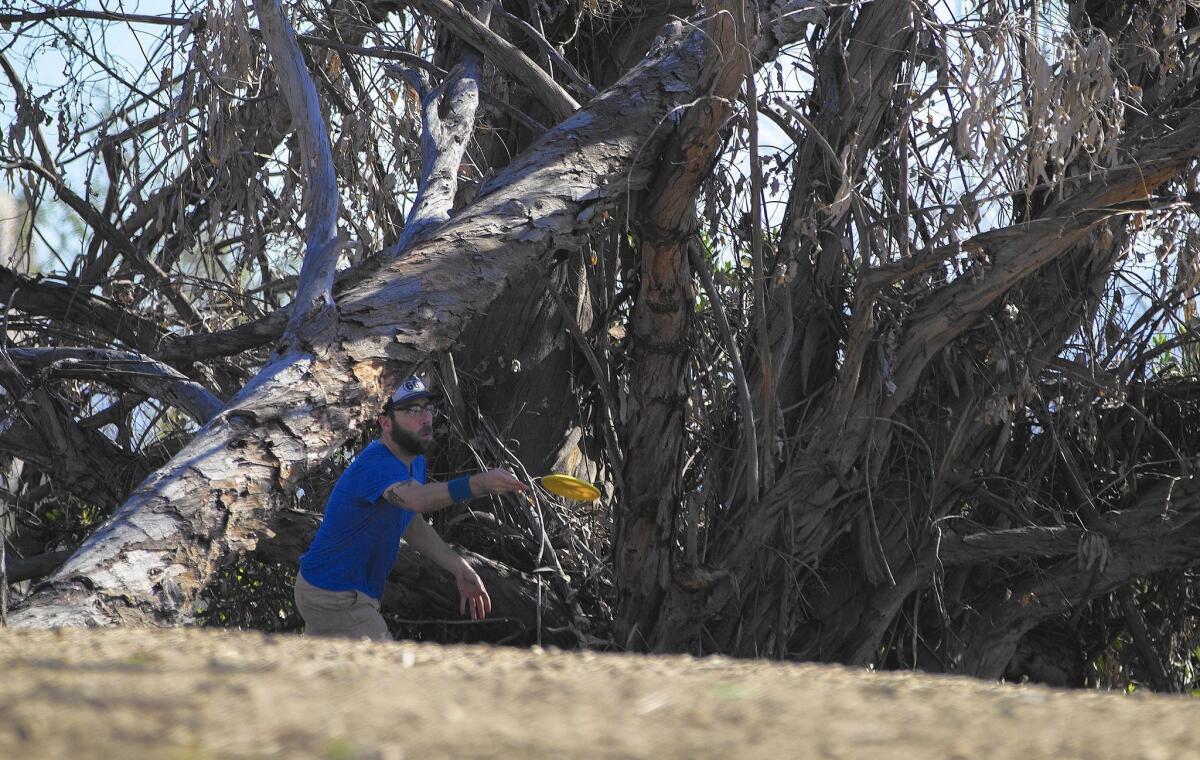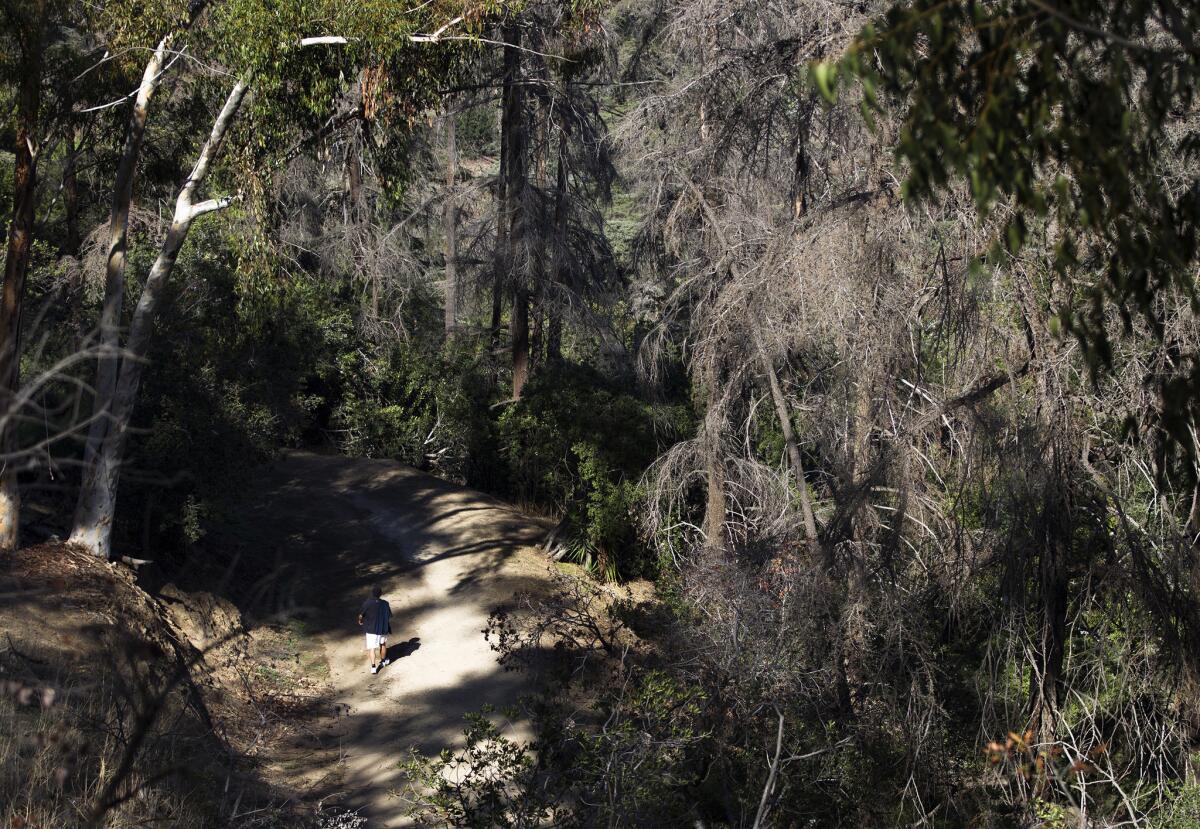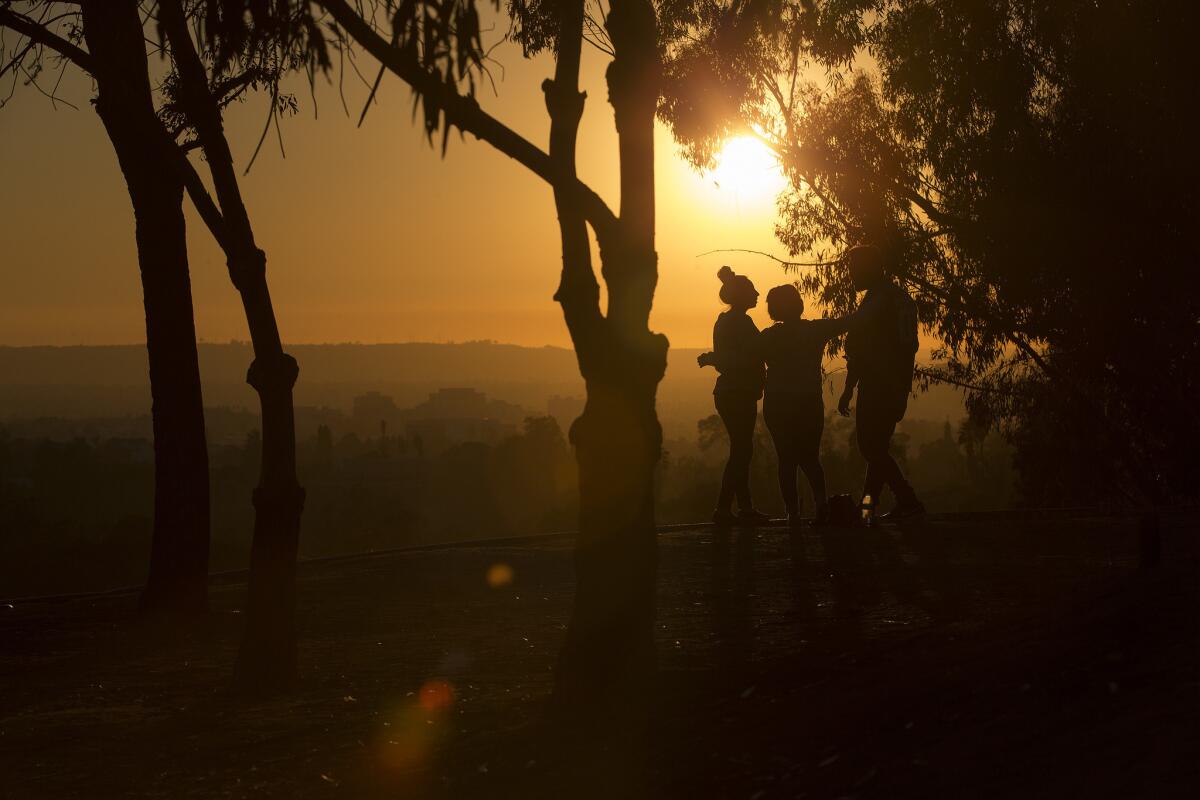Recovery plan lies dormant as Elysian Park’s exotic trees die off

- Share via
Around the turn of the 20th century, the dedicated stewards of Elysian Park were in an exotic mood. Eucalyptus, deodar cedar and Mexican palm were their fancy. Their canvas was the miniature range of ridges and sequestered canyons linked to downtown through Chavez Ravine, which decades later would become Dodger Stadium.
With access to federal recovery funds and plentiful labor during the Great Depression, they laid pipe and planted forests and glens that gave actual meaning to the park’s name, Elysian — the mythical place where the virtuous went after death.
Now, those forests, some 100 years old, are nearing the end of their life cycles. The irrigation system that sustained them is broken. Drought and pests have accelerated the effects of age. The trees are dying.
Today’s horticulturists have a new vision for the park: Let the nonnative species die out and replant the slopes with saplings of oak and walnut, gradually restoring the hillsides to the natural, and sustainable, ecosystem that Gaspar de Portola witnessed when he camped beside the Los Angeles River in 1769.
But that vision, articulated in a 2006 proposed master plan, is in no better health today than the exotic trees.
After a decade, the master plan has yet to be adopted. The L.A. Department of Recreation and Parks has no funds to remove hundreds of dead and dying trees and no plan to reintroduce native vegetation.

Stacey Martinez, Jessica Arellano and Kevin Martinez of Los Angeles balance on an old irrigation pipe in Elysian Park. The watering system has long been broken in many places in the park.
As a result, much of Elysian Park is slowly becoming a zombie forest of angular dead twigs silhouetted against blue sky and the downtown skyline.
Department officials find it difficult even to talk about the park’s condition. Asked to outline a plan, forester Laura Baurenfeind would not recommend any sort of triage to improve the park’s aesthetics or safety, or estimate the cost.
The department is building an electronic database of all the city’s 300,000 park trees, she said. The Elysian Park portion has not been completed.
“We would want to complete the inventory so we could assess what is here and prioritize,” Baurenfeind said.
Tom Gibson, the department’s landscape architect, said installing a reliable irrigation system in critical areas is the highest priority, followed by removing failed or failing trees. He would give no cost estimate.
Elysian Park may be the city’s best known and least known park. It is also the most complex. Its Gibraltar-like palm crested slopes mark the entry to downtown for hundreds of thousands of motorists on the 5 and 110 freeways.

A disc golf player makes a toss under dying trees in Elysian Park.
Behind those ramparts, a maze of roads connects mountain trails, vista points, a reservoir, quaint avenues of clapboard houses, the Los Angeles Police Academy, sprawling picnic grounds and the asphalt expanse of Dodger Stadium.
The park’s crisis remains largely unseen except by the predominantly Eastside families who flock on weekends to its cozy glens still kept a lush green by the last surviving lines of the aging irrigation system.
But two experts who toured the park with The Times said they were dismayed by its condition. They identified two emergencies arising from the park’s two major environments.
On the dry slopes, which haven’t been irrigated for many years, enough dried-out wood exists to feed a conflagration, they say.
“You have a lot of dead trees,” said Donald R. Hodel, a Los Angeles-based environmental horticulturist for the University of California Cooperative Extension. “They probably have to be removed. I’m not sure they could be left. It would probably be a big fire hazard.”

A canopy of dead and dying trees provides shade for a jogger in October.
More urgent, Hodel and arborist Jan Scow agreed, is the hazard of falling limbs in the glens and canyons where city workers struggle daily to keep the aging irrigation system working.
The trees there are large and lush but long overdue for pruning. Branches fall by the dozens during storms, and whole trees occasionally come down. Many of those dangerous trees are near picnic tables and trash cans, endangering visitors.
After branches fall, maintenance workers circle them with crime scene tape, then leave them on the ground for days before returning to cut them up.
On separate tours, Hodel and Scow pointed out numerous trees that had branches ready to fall.
Scow said a tree specialist certified in risk assessment by the International Society of Arboriculture should examine every tree in the park’s heavily used areas to identify those in need of immediate pruning.
“I appreciate that’s a matter of budget, but there are some safety factors there that are significant,” Scow said. “That’s something the city needs to look at.”
Join the conversation on Facebook >>
Baurenfeind, the city’s forester, said five new tree specialists have recently been added to the crew of 25, but they are spread too thinly to maintain all park trees.
A spokeswoman for the Recreation and Parks Department did not respond to a follow-up email from The Times asking if the city has a specialist qualified in risk assessment and when the last risk assessment was done.
Baurenfeind attributed Elysian Park’s condition to four years of drought. Other city parks and public lands are in similar condition, she said.
But a study commissioned as part of the 2006 master plan shows that the deterioration of the park’s nonnative forests long preceded the current drought.
In the draft master plan, Glendale landscape architects Withers & Sandgren identified dead and dying trees as an immediate concern and called for a dedicated crew to remove them. It also recommended a long-term plan to let the park transition to native, drought-tolerant species.

Palm fronds lie in a pile on the grass next a picnic area in Elysian Park earlier this month.
No crash program of tree removal was ever funded, and the plan, though posted on the parks department’s website, has not been adopted.
Asked via email why the plan remains on the shelf, department General Manager Mark Shull said the department’s vision is in line with the plan and pointed to the economic downturn as the reason it wasn’t formally adopted.
The Citizens Committee to Save Elysian Park, a volunteer group that advocates for the park, faults the department for not pushing for adoption of the plan.
“You would think within the political area that there would have been a push to get it approved,” said architect Pete Lassen, a committee member who lives next to the park. “Yet it has been sent to the Rec and Parks board, and nothing has happened.”
Along with other committee members, Lassen acknowledged some recent improvements, including the paving of the park’s circuitous roads and the restoration of its famed Avenue of the Palms. But as a priority, he considered roads much less urgent than clearing the dead trees and dangerous limbs.

A family enjoys the view on a dry slope at Angels Point in Elysian Park earlier this month.
Gibson, who is in charge of the park’s irrigation system, sees a brighter future when a recycled water line from the Glendale treatment plant will fill a large tank to be built by 2021 at a high point in the park. The tank will provide reclaimed water to the downtown area and supply a refurbished irrigation system in the park’s grassy areas, Gibson said.
Hodel and Scow said the native reforestation of the park’s dry portions cannot be achieved without a temporary irrigation system allowing saplings a year or two to become established.
Michael O’Brien, a member of the citizens committee and a landscape architect who recently retired from the city Planning Department, estimates that the cost to install temporary irrigation and replant the hillsides would be at least $2 million.
But for O’Brien, who lives in nearby Echo Park, the priority is removing the fire hazard.
“We hope it never happens, but someday somebody is going to drop a match or a cigarette and the whole thing will explode,” he said. “It’s just really a big pile of kindling right now.”
Twitter: @LATDoug
ALSO
San Diego expands criminal diversion program to include minor drug offenses
There’s plenty at home for Brown’s to-do list
Michelle King will head L.A. schools as the search for a superintendent continues
More to Read
Sign up for Essential California
The most important California stories and recommendations in your inbox every morning.
You may occasionally receive promotional content from the Los Angeles Times.














